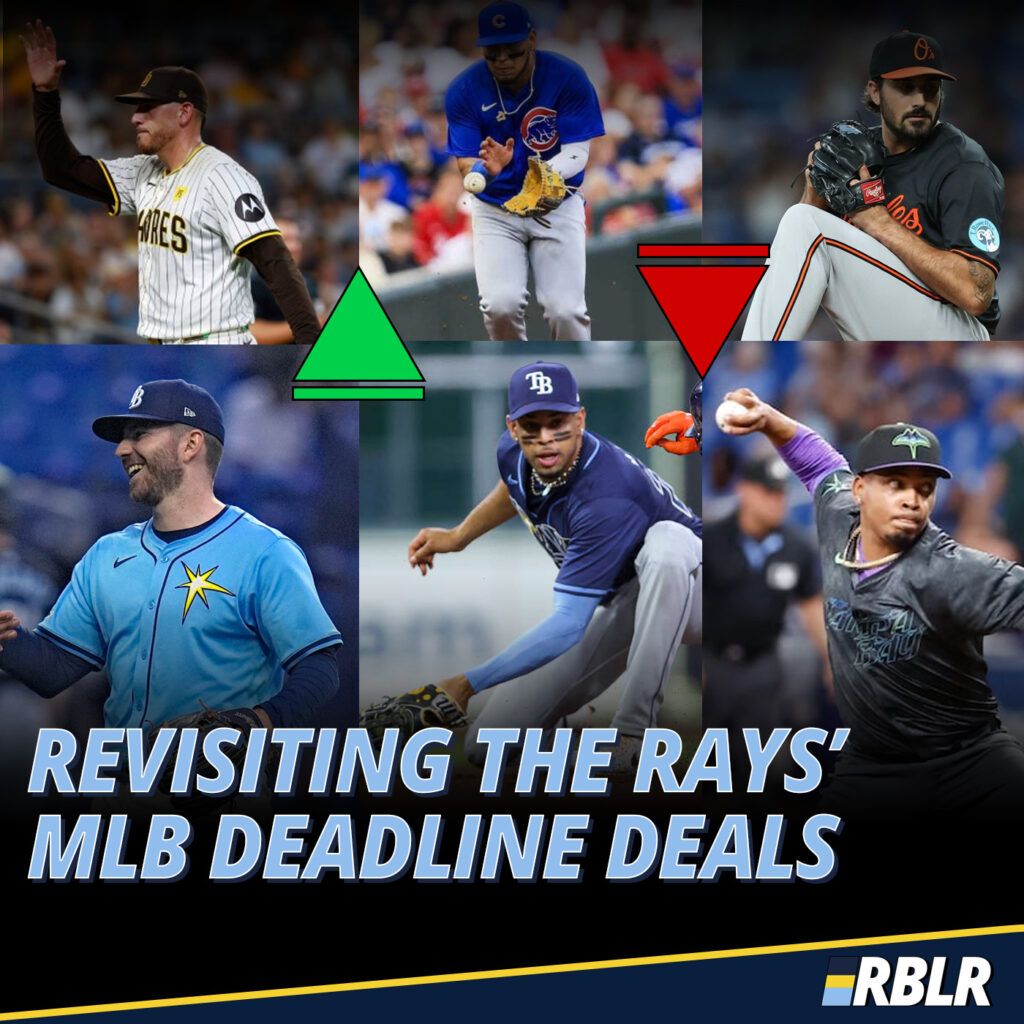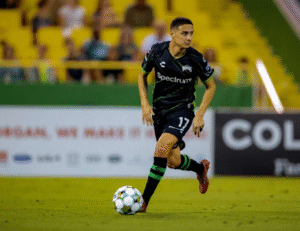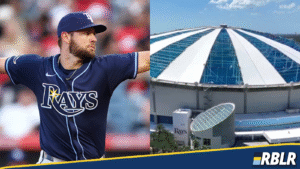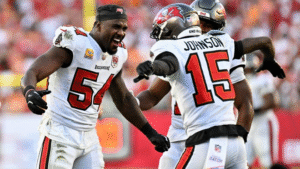Bunikiewicz: Revisiting The MLB Deadline Pickups

Since my last article, the Rays made a flurry of moves at the Trade Deadline. Four trades happened in that span — Zach Eflin to Baltimore, Jason Adam to San Diego, Isaac Paredes to the Cubs, and Amed Rosario back to his home in LA. I’ll touch up on the prospect returns for these trades in my next article, but, for now, let’s focus on the MLB talent given up and received for the Rays.
The Guys They Lost
Zach Eflin opened this year as the Rays’ Opening Day starter and the seeming Ace of the staff. Eflin was going to be in the prime of his career and, after his 177.2 IPs in 2023, looked to deliver on his ability as a quality innings-eater. He looked healthy in Spring Training but immediately ran into trouble by giving up 6 ERs in 5.2 IPs on 3/28.
Fast forwarding through the year, Eflin made one trip to the 15-day IL for lower back inflammation (he had a similar issue last year) and made 19 starts and ate 110 IPs. Although Eflin maintained his outlier ability to limit walks this year (2.7 BB%), he didn’t create the same weak contact and whiffs he had in his successful 2023. The batted ball results on his SI and SW changed quite a bit from ’23 to ’24: his SI generated an Exit Velocity (EV) of 86.6 at a -1 Launch Angle (LA) in ’23 – almost guaranteeing an automatic out — to a 91.9 EV and 4 LA in ’24. The SW featured a similar issue with an 85.1 EV and 15 LA to a 89.6 EV and 29 LA. The SI’s location shifted in ’24 to hit more of the outer third of RHBs and inner third of LHBs for called strikes. It’s safe to say that batters were reading Zach better this year than last year.
Another reason the Rays removed Eflin is because they have multiple SPs coming back from the IL and young SPs with explosive stuff who create more valuable contributions to the roster at this point in the season.
Adam was picked up as a minor-league free agent two years ago. He’s always had great stuff due to his deception, pitch shapes, and supination bias but hadn’t put together a successful season in 4+ years. Adam went to Tread Athletics, one of the best pitching facilities in the private sector, and developed a seam-shifted wake CH, a plus SW, and added carry and velocity to his FF.
In 2024, Jason Adam was easily one of the best RPs in baseball. Adam threw 49 IPs with 1 35.1% whiff (top 4% of pitchers in baseball), a 31.2% chase, and his CH returned a 4 Run Value on Savant. JA’s success came through re-adding his gyro SL to bridge his FF/SW combo and to get in-zone more often. His SL also had a 48.4% whiff. Another notable difference for Adam this year versus his past two seasons with the Rays is his overall FF usage. His FF is a great pitch at its -4.5 VAA (flatter than average) and his career high in velocity on it (95 mph) led to its 40% usage. In years past his FF usage was under 40%, and he leaned hard on his secondaries.
This move was more about the opportunity to get the prospects offered by the Padres and to capitalize on JA’s current value rather than the current quality of JA’s contributions to the teams and his personality. Although Adam performed well this year, the Rays realized the value that high-leverage RPs had on the market and traded Adam for a 1st round SP, a speedy OF prospect, and a C with upside. Adam, 33, will only have worse stuff as he gets older and so his contract will be worth less than his value the longer he stays with the Rays.
The last piece of this trade is that the Rays have a couple of MLB RPs coming up and need spots to find the next JA.
The last two pieces that were traded away at the deadline were Isaac Paredes and Amed Rosario. Both of these guys filled starting roles with the Rays this year — Paredes was the primary 3B and an All-Star, and Rosario was a super utility man with plus speed.
Paredes was the pulled fly-ball king (53.2% pull!) and sported a 130 wRC+ at the time of his trade. He also posted quality plate discipline with a 17.4 whiff%, 15.8 K%, and 11.6 BB%.
Rosario has a 29.1 ft/sec sprint speed (ranks 93rd percentile in the MLB), a 17.5 K%, and a 112 wRC+ on the year.
Both of these players were integral parts of the Rays offense and infield, but a team needs to trade valuable pieces to get better pieces in return.
The Guys They Got Back
Jeffrey Springs is the quality, front-of-the line SP that the Rays needed at the deadline, and, now, they have his returning from the IL. Springs is a North-South pronator with a mix of FF/CH/SL/SW/SI. His pronation bias means he has an easy time generating a plus FF and CH shape. He generates whiffs on the FF/CH combo because of its velocity separation (10 mphs) and its Vertical Approach Angle difference (-5 VAA on the FF, -9 VAA on the CH). Springs has a deceptive, cross-body delivery and fools hitters with seemingly below-average stuff.
Although often encumbered by injuries as he dealt with a season-ending knee injury in ’21 and Tommy John Surgery at the start of ’23, Jeffrey Springs is an excellent pitcher when healthy. From ’22 to ’23 Springs had 151.1 IPs with 168 Ks, posting a couple of elite stats: 35.4 chase % (top 4% in the league), 29.5 whiff %, 26.2 K%, 6 BB%, and average exit velo of 88 mphs.
Springs was poised to break-out in ’23 before his injury and will provide invaluable innings to the Rays down the stretch run.
Christopher Morel was the main piece of big-league talent acquired at the deadline this year. Morel possesses a fiery personality, top-of-the-scale exit velos and bat speed — 92.1 avg. exit velo in ’23 and 76.3 mph bat speed which is in the top 3%, and elite athleticism, comparable to Jose Siri. The main issues with Morel is that he needs to find defensive home and that he whiffs a ton. He’s been relatively unlucky this year, and it seems that the Rays are already getting him to pull fly balls more. His floor is a serviceable, almost bat-first UTIL, and his ceiling is an MVP-caliber MIF.
Hunter Bigge was the main arm acquired by TBR at the deadline. He’s a fire-balling RHP with a FF/SL/SW/CU mix. He’s a North-South pronator whose stuff grades out as elite on paper with big deception due to his short arm action. He’s an optionable, high-upside arm with 42 K% in the minors at the time of his trade. He needs to work on leveraging counts and sequencing his pitches but has the chance to step into a high-leverage role sooner rather than later.
https://x.com/rekrabmb/status/1817639095654568105
The Rays also had another acquisition at the deadline, Edwin Uceta. Although added to the organization as an MiLB depth guy back in January, Uceta has the funk, stuff, and command that the Rays look for in their high-leverage arms. Uceta is an East-West supinator with a SI/CH/FC/SW combo. The SI and CH both have whiffs above 30%, and his current line on the year is 25.2 IPs and 30 Ks. He’s also sporting a 34.2 chase %, 3.3 BB %, and 3.4 Barrel %. He’ll most likely be taking JA’s role, but he has the ability to pitch multiple innings and could even work as a quality bulk arm in the future.
Although the Rays might seem out of the play-offs to the casual fan, the team is in an arguably better place to make the play-offs without the likes of Eflin, Randy Arozarena, and Paredes.
The Rays are 24-19 since June 20th this season and are building on the past 5 years of play-off experience to make a run in the playoffs this year. All the Rays need to do is get in the play-offs; the D-backs made a World Series run on an 84-78 record last year. Once the Rays get their injured core back, they have a chance to make a deep postseason run and do something special.







